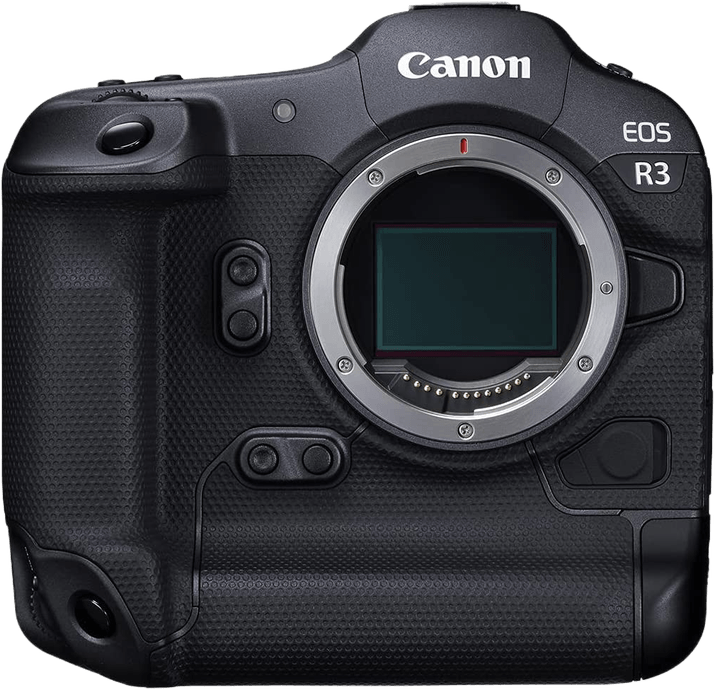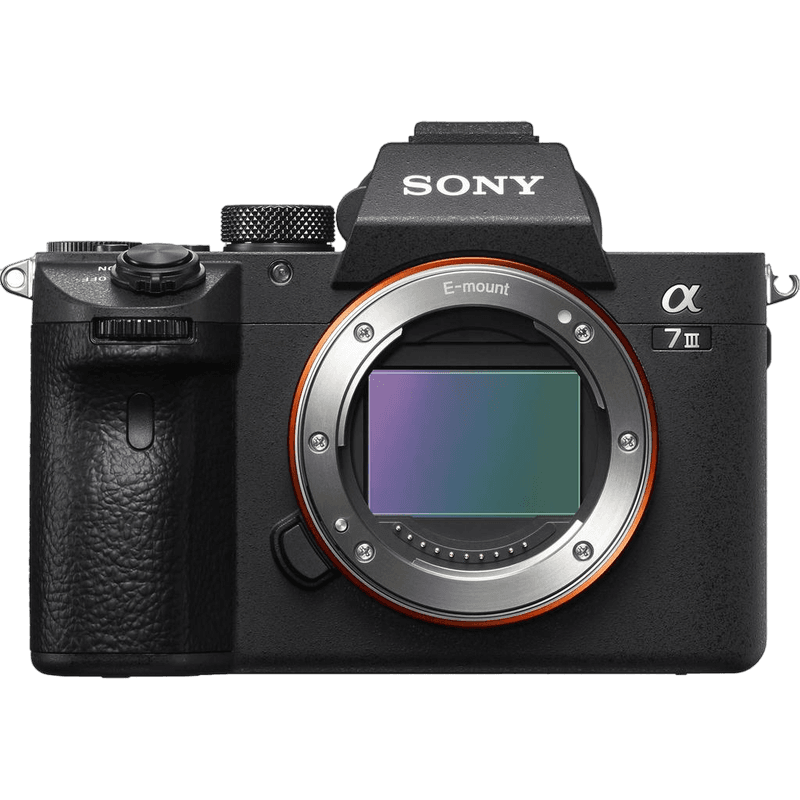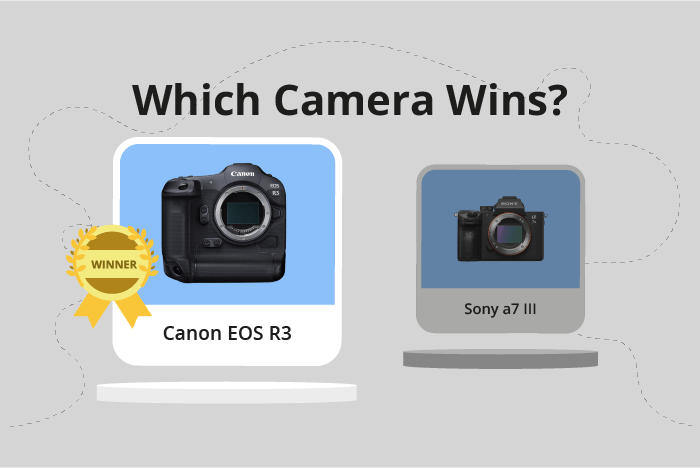Canon EOS R3 vs Sony a7 III Comparison
Canon EOS R3

Sony a7 III

The Canon EOS R3 outperforms the Sony a7 III with a score of 84 compared to 81. Both cameras share similarities as mirrorless models with compact designs. The Canon EOS R3, released in 2021 and measures 150 x 143 x 87mm, weighing 2.24lbs. The Sony a7 III, released in 2018 and measures 127 x 96 x 74mm, weighing 1.43lbs.
The Canon EOS R3’s higher score reflects its superior performance and advanced features. Its larger size and weight indicate a more robust build and potential for greater durability. However, the Sony a7 III has the advantage of being lighter and more compact, making it easier to carry and handle during shoots. Additionally, the Sony a7 III offers a more budget-friendly option with its lower launch price.
When considering these specifications, the Canon EOS R3 emerges as a better option for professionals seeking top-tier performance, while the Sony a7 III caters to those prioritizing portability and affordability.
Canon EOS R3 vs Sony a7 III Overview and Optics
The Canon EOS R3 emerges as the winner in the optics comparison, scoring 84/100, while the Sony a7 III trails slightly behind with a score of 81/100. Both cameras share several key specifications, including 24-megapixel CMOS sensors, full-frame sensor size, and image stabilization. Additionally, they both have a DXOMARK sensor score of 96, indicating that their sensors perform similarly in terms of image quality.
The Canon EOS R3 outperforms the Sony a7 III in several aspects. Its shooting speed of 30 frames per second (fps) is significantly faster than the Sony a7 III’s 10 fps, allowing for better capturing of fast-moving subjects. Moreover, the Canon EOS R3 features a more advanced Digic X processor, which contributes to improved image processing and overall camera performance.
On the other hand, the Sony a7 III has a slight advantage in terms of megapixels, boasting 24.2 as opposed to the Canon EOS R3’s 24. Additionally, the Sony a7 III utilizes the Sony FE lens mount, which offers a wide range of compatible lenses for various photography needs. However, these advantages may not be significant enough to outweigh the benefits provided by the Canon EOS R3’s faster shooting speed and advanced processor.
Taking these factors into account, the Canon EOS R3 stands out as the superior choice in terms of optics, due to its faster shooting speed and advanced processor. However, the Sony a7 III remains a solid option for photographers who prioritize a wider range of compatible lenses and a slightly higher megapixel count.
Canon EOS R3 vs Sony a7 III Video Performance
The Canon EOS R3 outperforms the Sony a7 III in video capabilities with a score of 96 out of 100, compared to the Sony a7 III’s score of 70. Both cameras share some common video specifications, but the differences in their performance are significant.
Both the Canon EOS R3 and the Sony a7 III have the ability to record high-quality video. However, the Canon EOS R3 is superior in several aspects. The EOS R3 can record at a maximum resolution of 6K, with dimensions of 6000 x 3164 pixels. This higher resolution allows for more detailed and sharper video footage. Additionally, the EOS R3 has a maximum video frame rate of 120fps, providing smoother motion and the ability to create stunning slow-motion footage.
The Sony a7 III has a maximum video resolution of 4K and dimensions of 3840 x 2160 pixels. While this resolution is still considered high-quality, it falls short when compared to the EOS R3’s 6K capabilities. The a7 III’s maximum video frame rate is 30fps, which is significantly lower than the EOS R3’s 120fps. Despite its lower score, the Sony a7 III may still be a suitable choice for users who prioritize other features or have a lower budget. However, for those who require high-quality video capabilities, the Canon EOS R3 is our clear winner.
Canon EOS R3 vs Sony a7 III Features and Benefits
The Canon EOS R3 outperforms the Sony a7 III with a feature score of 87/100, compared to the Sony a7 III’s score of 81/100. Both cameras share several common specifications, including touchscreen capabilities, flip screens, WIFI, and Bluetooth connectivity.
The Canon EOS R3’s superior features include a larger screen size of 3.2 inches and a significantly higher screen resolution of 4,150,000 dots. This results in a clearer, more detailed display for easier navigation and image review. Furthermore, the Canon EOS R3 offers GPS functionality, allowing users to geotag their images for precise location data.
On the other hand, the Sony a7 III, while scoring lower in features, still offers a solid set of specifications. It has a slightly smaller screen size of 3 inches and a lower screen resolution of 921,600 dots. Despite this, the Sony a7 III maintains a high-quality display and shares the same essential connectivity options as the Canon EOS R3, excluding GPS.
In terms of features, the Canon EOS R3 holds a clear advantage over the Sony a7 III, particularly in screen size, screen resolution, and GPS capabilities. However, the Sony a7 III remains a strong contender in the market, offering many similar features to the Canon EOS R3. Users should consider their specific needs and preferences when choosing between these two cameras, as both provide high-quality options for photography enthusiasts.
Canon EOS R3 vs Sony a7 III Storage and Battery
The Canon EOS R3 and the Sony a7 III score highly in storage and battery with a score of 81. Both cameras share the same number of memory card slots, which is two. They also accept SD/SDHC/SDXC cards, but the Canon EOS R3 supports CFexpress Type B cards (UHS-II compatible), while the Sony a7 III uses Memory Stick Duo/Pro Duo/Pro-HG Duo cards.
The Canon EOS R3 offers a slightly longer battery life with 760 shots compared to the Sony a7 III’s 750 shots.
Canon EOS R3 vs Sony a7 III – Our Verdict
Are you still undecided about which camera is right for you? Have a look at these popular comparisons that feature the Canon EOS R3 or the Sony a7 III:

